Revolvers from Texas: real and not so
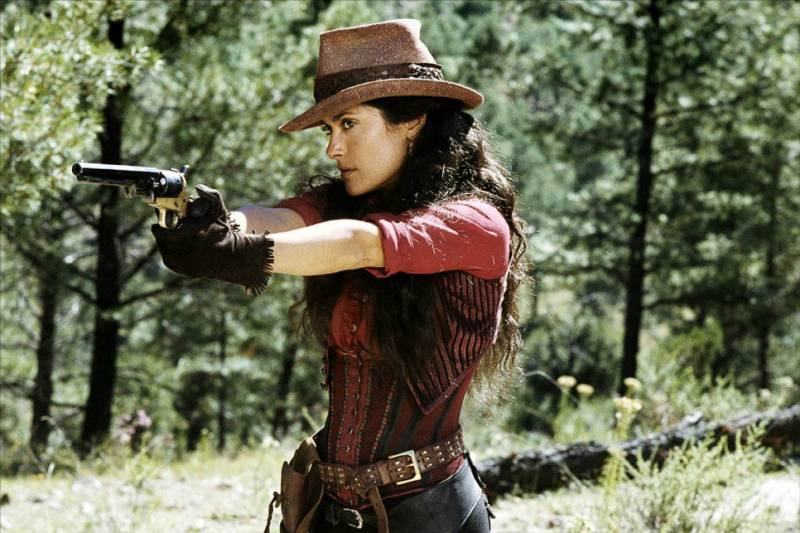
A still from the film "Bandits" (2006). The film is, of course, so-so. For children and adolescents, and not advanced. But weapon it shows well. And this girl is just shooting a Texas Colt. In any case, it is very similar. And then it happens in Mexico, and Texas is there.
White Earp
(American guardian of law and gambler in Kansas and Arizona).
Shoot first and never miss.
Bat Masterson
(a person as legendary as White Earp, besides his friend).
Weapons and firms. We continue our story about the Confederate revolvers, which they either bought in Europe, or obtained in battles, or made in their “country of Dixie” at more or less equipped enterprises. Some did, others only pretended to do. In any case, the Confederation happened to write in history American weapons have a whole series of pretty interesting pages.
It has already been said that the bulk of the Confederate Civil War revolver manufacturers were either in Georgia or Texas. And it just so happened that much more is known and written about manufacturers from Georgia in America than about those who then lived in Texas.
Meanwhile, there were two manufacturers who also played a role in the armament of the Confederation, although in different ways. These were JH Dance and Brothers and the Lancaster pistol factory. The last of these two produced the revolvers we've already covered: Tucker and Sherrard and Clark and Sherrard.
Today we will talk about revolvers of the company "Dance and Brothers". And it is worthwhile to immediately make a reservation: it was previously believed that this company did not have a contract for the production of weapons either with the government of the Confederation or with the Military Council of the State of Texas. It was also said that although the Lancaster firm had a contract with the Texas War Council, it never produced revolvers during the war. But the revolvers of the company "Dance" are known, but it seems that they were not produced.
If you consider that Texas was a place where cattle were herded, and where thugs of all stripes (card cheaters and crooks) fled, it is downright surprising that there anyone could produce at least something more complicated than a toothpick. However, this was the case.
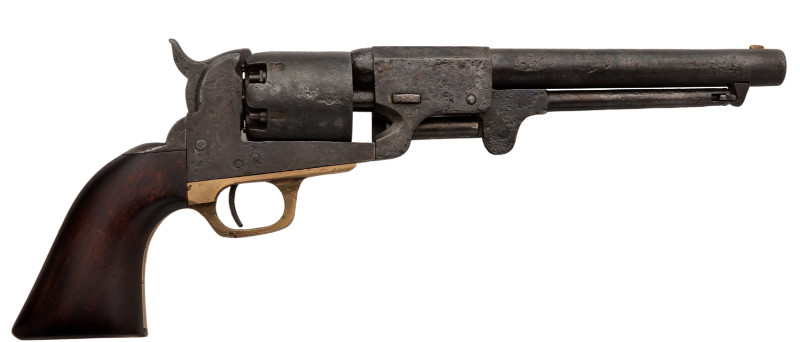
Revolver "Dance" is a desirable object for auctions and collectors. Even if the state is not very good. This one, for example, in 2018 at the auction house "Paul Fraser Collectibles", the starting price was $ 37. Photo from the site "Paul Fraser Collectibles".
Well, the beginning of such an outstanding family was laid by Thomas Dance from Virginia, from where members of his family reached Texas through North Carolina and Alabama. The four Danes brothers settled in Brasoria County in 1853. Where they became well, just the outstanding gunsmiths in Texas history and a renowned family among the Confederate gunsmiths. Their names were James Henry, George Perry, David Ethelred and Isaac Claudius Dance. Harrison's cousin Perry Dance was also involved in their business, which the brothers set up in Columbia, on the banks of the Brazos River near Houston and Galveston.
And they had a modern factory
Today their enterprise would be called a mechanical workshop. But at that time it was a modern factory with its own steam engine. When the Civil War broke out, the brothers decided that they should start producing revolvers for the Confederation. This decision was probably made at the end of 1861 or at the beginning of the next. But here it should be noted that the Danes brothers never received financial assistance from the Confederate government or the Texas War Council to start production. And the whole business was organized at your own peril and risk.
It is also interesting to note that all four brothers enlisted in the Confederate Army, enrolling in the 35th Texas Cavalry (Brown's). American historians of weapons and collectors today argue about how these revolvers are best called: about "Dance" or "Dance and Parks"? Since there were two more Park brothers who also worked at this plant and seemed to take an active part in the production of revolvers, that is, they were partners of the Danes brothers.
In any case, records from the National Archives show that in all business correspondence the firm is referred to as Dance and Park, and not as Dance and Brothers. This indicates that there must have been some form of business relationship between them. And also that the Danes brothers were very scrupulous people about business. Although only his ... "southern"!
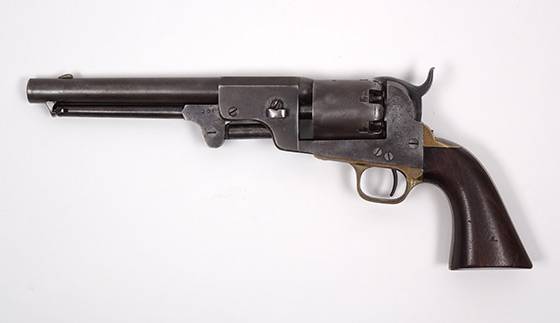
Revolver "Dance" .44 caliber, steel, weight 3,5 lbs. Bullock Museum - Texas State History Museum.
The Danes brothers achieved significantly greater success than many other Confederate revolver manufacturers, and were able to organize efficient production in their factory. In a letter from my sister to one of the brothers on July 5, 1862, we read:
On February 25, 1863, she wrote:
What if all workers are drafted into the army?
A big problem was the lack of skilled workers due to the Confederate Conscription Act. According to which they called all white men between the ages of 18 and 35, without exception. The only recourse was to persuade the army to send blacksmiths and mechanics to work in the factories, although few firms were successful along the way.
The Danes brothers, however, were also able to convince the military here that experienced workers would be more useful in their factory than in the trenches. More than 35 soldiers were sent to the plant. And at least 23 of them from the 35th Texas Cavalry Regiment (Brown's Regiment) were experienced metalworkers. Although, why be surprised? James Henry Dance, was one of the officers of this regiment. So there is a direct abuse of official position, albeit in the interests of the common cause.
However, the command of Brown's regiment did not object to such an initiative of their officer. The prospect of getting more revolvers was undoubtedly a strong incentive to send soldiers to the factory. In a letter from George Duff to Matty dated August 29, 1863, he writes:
It was always believed that the Danes brothers never entered into contracts with the state of Texas or the government of the Confederation. Now it can be shown that this is not the case. In a letter from Edmund P. Turner to Dance and Park on June 26, 1863, Turner states:
However, on November 16, 1863, the Confederate State Army issued Order # 312 in Texas County:
So there was a contract? Otherwise, the official document would not have referred to him.
The factory was then relocated to Anderson, away from the state line. Production did not start immediately, but it did. And already in 1864 the brothers' firm created revolvers in calibers and .44 and .36. In total, about 135 first-caliber revolvers were produced and, possibly, another 135 second-caliber revolvers. Some of the weapons were issued to army officers, and some of them went on the free sale.
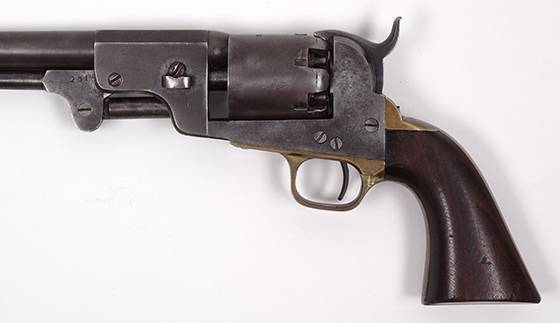
Revolver "Dance" close-up. Bullock Museum - Texas State History Museum.
The Dance revolvers were modeled after the Colt revolvers. At the same time, .44 and .36 caliber revolvers were similar in appearance, except for the size. Basically, they had a round barrel, like the Dragoon Colt, although in some instances the barrel is completely octagonal. "Dance" .44 caliber is comparable in length to a Colt, but weighs less. The barrel has seven grooves with clockwise rotation and constant curvature. The trigger guard is square, thick and heavy, and its thickness increased as production continued.
The Tucker and Sherrard revolvers, manufactured in Lancaster, and also in Texas, were described in one of the past materials. These revolvers were most likely manufactured during the war and sold to individual soldiers. The .36 caliber revolver was similar in size to the 1850 Navy Colt, but had a round barrel.
Tucker & Sherrard: When Firms Promise Much But Do Nothing
As for the history of the Tucker & Sherrard pistol factory, it began with an announcement in the Dallas Herald on February 19, 1862:
On March 6, 1862, the War Council wrote to John M. Crockett of Dallas, Lieutenant Governor of Texas, to
Crockett answered. And so that it can be understood in two ways:
Already on April 11, the Military Council offered "Messrs. Tucker, Sherrod (sic) and Co." $ 5 in advance upon signing the contract with a performance guarantee. The contract promised the Board of Directors a purchase at $ 000 per revolver. Moreover, the Council also promised
That is, 100 pistols for every month after May. The document also stipulated:
The Lancaster entrepreneurs who signed this contract were Laban E. Tucker, Joseph H. Sherrard, W.L. Killen, A.W. Tucker, Pleasant Taylor and John Crockett.
How the Lieutenant Governor took matters into his own hands
On June 30, 1862, that is, by the final delivery date of the first batch, Crockett was forced to write to the council of war:
On July 21, another letter followed, in which many objective reasons were named. Why revolvers were never there. By August 5, they were still gone. On October 2, Sherrard, Taylor & Co. (new name as of mid-August) was never able to deliver any weapons.
But the Military Council nevertheless gave the firm another $ 5. The $ 000 bond was signed by Sherrard, Keellen, Taylor, Crockett, G.V. Record and R.M. Hope. New reason for the delay, which Crockett complains about this time, is that factory workers are being drafted into the army.
Then a new letter followed:
Finally, in January, Crockett traveled to Austin, Texas, where the State Legislature opened. And he took with him two ready-made revolvers, presumably produced at the plant in Lancaster. He later reported that the pistols had been tested
On February 28, the Texas Almanac Gazeta noted:
Isn't it all very similar to what our own media report to us today with enviable regularity? That is, nothing has changed in people's lives, in principle. Is that now we are talking not only about pistols, but also about missiles, tanks and ships. And not only in the USA, but also here. However, the market is the market.
Well, it all ended with the fact that (with the exception of "pilot pistols") none of the infamous 400 revolvers was never delivered to the state.
Months dragged on, and Crockett kept finding the reasons for the delay: lack of materials, recruiting workers for military service, lack of coal, etc. As a result, it all ended with the termination of the contract and the withdrawal of all funds. However, what was returned under the contract has become much cheaper due to inflation. But the Confederate Bank had to "swallow" it, since the terms of the contract did not stipulate inflation. Withdrawal of the contract ended the firm of Sherrard, Taylor & Co., but by no means the commercial activities of the factory itself.
In general, after reading materials from the Texas archives, American historians argue that it is quite conclusively possible to conclude that Colonel Crockett, together with his companions, really produced revolvers, but they sold them on the market at a higher price than the state military council allowed. Texas. The military authorities of the state simply fooled, and simply put all the profits in their pocket. That was such an interesting story with "revolvers from Texas" that took place during the Civil War of the North and South.
However, the rarest Texas revolvers, of which there were only six pieces, were the Sisterdale. And all of them were made by a group of Texans of German origin, who were soldiers of Company F, 36th Cavalry Regiment of Texas.
Eight Germans made six revolvers
And it so happened that in August 1862 Alfred Kapp (possibly the only experienced gunsmith who worked at the Colt factory in Connecticut), as well as Rudolph Coret, Charles "Karl" Coret, Johann Koret (all brothers), Adolf Munzenberger, August Schimmelpfennig, Herman Cammerling and a blacksmith named Schmidt or Willem were sent to Sisterdale (a small town northwest of San Antonio) to produce a six-shooter revolver. Their goal was to negotiate a contract with the Confederation, which faced a critical shortage of firearms. And the Texas government has decided to encourage the production of firearms, so to speak, at home.
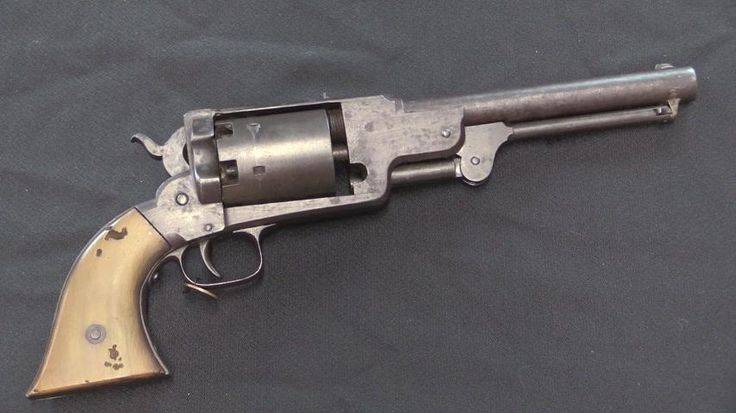
Revolver "Sisterdale".
It was these Germans who made a revolver there, which was somewhat larger than its counterpart (all the same Colt revolver) and, moreover, weighed four pounds. But he could shoot. And it could be produced even in a more or less equipped workshop.
Ernst Kapp himself was a German immigrant, born in Minden, Germany. He arrived in Galveston, Texas with his family in December 1849. In early 1850, he bought a farm with a small plot of land near Sisterdale (a small settlement about 40 miles north of New Braunsfeld on the Guadalupe River), where many German immigrants had already settled before him. In about 1860, Kapp was elected magistrate in a small community. When the Civil War broke out, he was appointed a senior officer under the command of Enl Robert Beecham, who commanded the 31st Texas Guards Brigade, and was ordered to form a volunteer company in Sisterdale. His eldest son Alfred Kapp became the captain of this company.
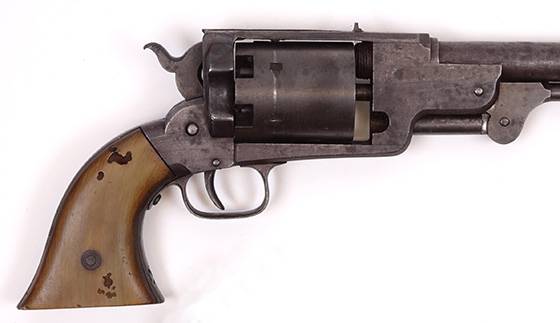
The Sisterdale revolver, as you can see, had a closed frame.
A number of American historians believe that before the war, Alfred worked for some time at the Colt factory in Hartford. This experience undoubtedly gave him the skills needed to manufacture revolvers for the Confederation. A total of six revolvers were made, of which only one has survived to this day.
Originally it belonged to Miss Otto Coret, and for a long time it was exhibited in the Sofinburg Museum near New Braunsfeld, of which this lady was the caretaker. Today it is in the famous collection of Charles Schreiner III of Kerrville, Texas.
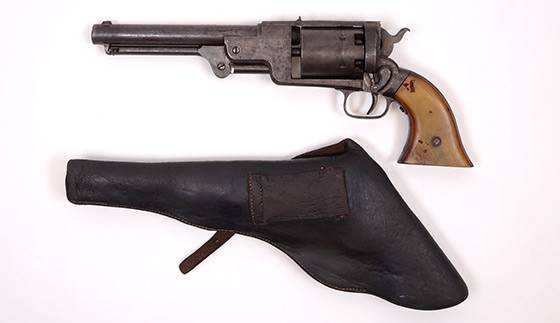
Revolver "Sisterdale" and holster to it.
The revolver resembles both the Colt Navy and the very first examples of Remington's pocket revolvers. It is a single-action .36 caliber five-shot capsule revolver. The main highlight of the design was the drum pusher lever, which was openly installed on the frame of the revolver on the left, which is clearly visible in the photo. This, of course, is not a very good solution in technical terms, but it was quite workable.
Although the production of only six revolvers had no impact on the war, Sisterdale is unique in that it was made by a group of disabled soldiers in a workshop that had been converted to a simple farm shop. This gives us today an idea of how much these people were devoted to their work and what skillful hands they had.
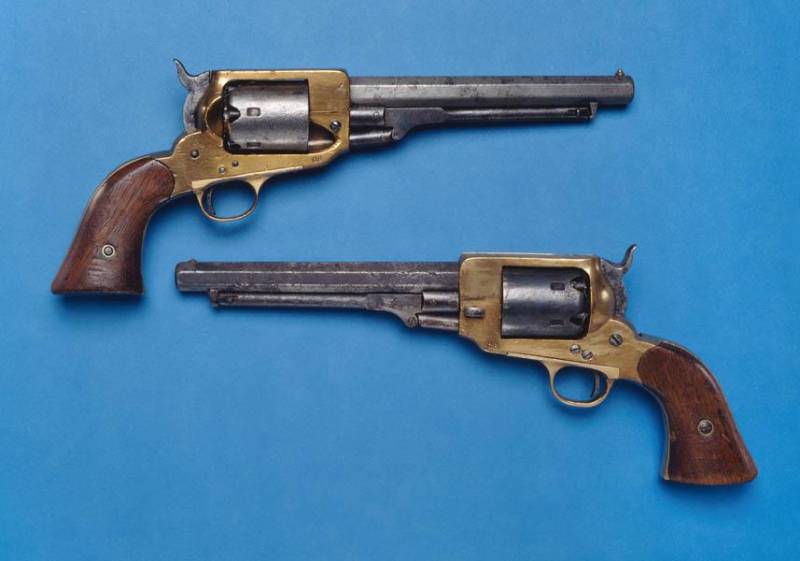
Information